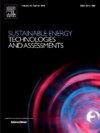二氧化碳排放的生物电化学转化作为温室气体捕获和可再生电力存储策略:推进电力制甲烷技术-综述
IF 7
2区 工程技术
Q1 ENERGY & FUELS
Sustainable Energy Technologies and Assessments
Pub Date : 2025-06-16
DOI:10.1016/j.seta.2025.104394
引用次数: 0
摘要
电甲烷生成是一种创新的生物电化学过程,作为最有前途的电力制气(P2G)技术之一,在能源转型框架内迅速受到关注。这一过程能够通过产甲烷古菌的代谢活动,将间歇性可再生能源产生的电力以及二氧化碳排放转化为高纯度的甲烷。它与现有的甲烷储存、分配和利用基础设施的兼容性进一步扩大了其潜力,使其成为可再生能源储存和减少温室气体的极具吸引力的解决方案。这篇综述严格审查了最近在电甲烷生成方面的进展,特别强调了确定可行的二氧化碳来源。其中,天然气喷口的地热排放被强调为“地热电甲烷生成”的关键机会,而工业废气则被探索通过减少温室气体排放和产生可持续的“绿色”甲烷来减轻环境影响的潜力。此外,综述强调需要进一步开发可持续和低成本的电极和腔室分离器材料,以提高该工艺的经济和环境可行性。它深入研究了微生物代谢途径、接种物和支撑电甲烷生成的操作条件,解决了从实验室规模研究到大规模实际应用的关键挑战。本文章由计算机程序翻译,如有差异,请以英文原文为准。

Bioelectrochemical conversion of CO2 emissions as greenhouse gases capture and renewable electricity storage strategy: advancing power-to-methane technologies − a critical review
Electromethanogenesis is an innovative bioelectrochemical process that is rapidly gaining attention within the energy transition framework as one of the most promising Power-to-Gas (P2G) technologies. This process enables the conversion of electricity generated from intermittent renewable sources, along with carbon dioxide emissions, into high-purity methane through the metabolic activity of methanogenic Archaea. Its potential is further amplified by its compatibility with existing infrastructure for methane storage, distribution, and utilization, making it a highly attractive solution for renewable energy storage and greenhouse gas reduction.
This review critically examines recent advancements in electromethanogenesis, placing particular emphasis on identifying viable CO2 sources. Among these, geothermal emissions from natural gas vents are highlighted as a key opportunity for “geothermal electromethanogenesis,” while industrial off-gases are explored for their potential to mitigate environmental impact by reducing greenhouse gas emissions and producing sustainable “green” methane.
Moreover, the review underscores the need for further development of sustainable and low-cost materials for electrodes and chamber separator to enhance the economic and environmental feasibility of this process. It delves into the microbial metabolic pathways, inoculum, and operational conditions that underpin electromethanogenesis, addressing the critical challenges of upscaling from laboratory-scale research to large-scale, real-world applications.
求助全文
通过发布文献求助,成功后即可免费获取论文全文。
去求助
来源期刊

Sustainable Energy Technologies and Assessments
Energy-Renewable Energy, Sustainability and the Environment
CiteScore
12.70
自引率
12.50%
发文量
1091
期刊介绍:
Encouraging a transition to a sustainable energy future is imperative for our world. Technologies that enable this shift in various sectors like transportation, heating, and power systems are of utmost importance. Sustainable Energy Technologies and Assessments welcomes papers focusing on a range of aspects and levels of technological advancements in energy generation and utilization. The aim is to reduce the negative environmental impact associated with energy production and consumption, spanning from laboratory experiments to real-world applications in the commercial sector.
 求助内容:
求助内容: 应助结果提醒方式:
应助结果提醒方式:


